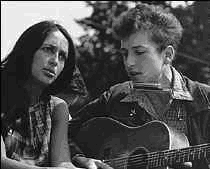BOB DYLAN
 Bob Dylan, born Robert Allen Zimmerman, was the most influential American singer and composer of popular music in the sixties. His lyrics incorporated politics, social commentary, philosophy and literary influences, defying existing pop music conventions and appealing widely to the counterculture of the time. Bob Dylan, born Robert Allen Zimmerman, was the most influential American singer and composer of popular music in the sixties. His lyrics incorporated politics, social commentary, philosophy and literary influences, defying existing pop music conventions and appealing widely to the counterculture of the time.
Dylan's engagement with the civil rights movement in 1962-1963 led to his topical protest songs that also succeeded as art. "Blowin' in the Wind", his best-known song became an anthem of the civil rights struggle.
"Another Side of Bob Dylan" (1964), his next album, shocked his fans. He dismissed social issues and sang personal songs that expressed, among other feelings, considerable bitterness toward women. He began a romantic relationship with fellow folk singer Joan Baez who he played live with, early in the year. He gave his folk song "Mr. Tambourine Man", which he was recording for his new album, to the Byrds to record as an electric arrangement and the song was a huge hit for them.
 Dylan's mid-sixties rock can be described as energetic, turbulent, and hallucinogenic: "Bringing It All Back Home" and "Highway 61 Revisited" (1965) captured an enormous audience. "Like a Rolling Stone", the most enduring and successful song of this period, expressed the frustrations of sixties' youth and gave voice to their rebelliousness. It marked the high point of Dylan's role as spokesperson for the generation. Dylan's mid-sixties rock can be described as energetic, turbulent, and hallucinogenic: "Bringing It All Back Home" and "Highway 61 Revisited" (1965) captured an enormous audience. "Like a Rolling Stone", the most enduring and successful song of this period, expressed the frustrations of sixties' youth and gave voice to their rebelliousness. It marked the high point of Dylan's role as spokesperson for the generation.
Dylan was in a near-fatal motorcycle accident that broke his neck. He retreated to his home in Woodstock to mend and spend time with his companion Sara Lowndes. Dylan returned in December of 1967 with the country rock album "John Wesley Harding", recorded in Nashville. The next album released in '68, "Nashville Skyline" was even more country.
Listen to: Bob Dylan - Blowin' in the wind
|

